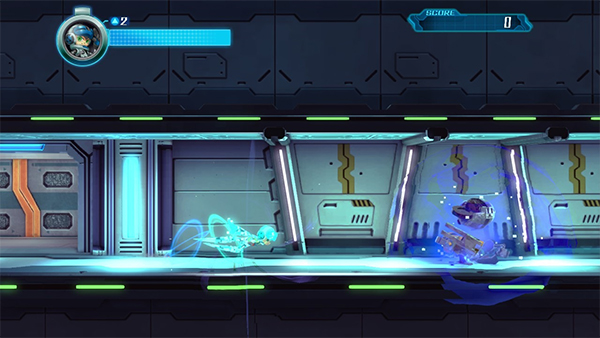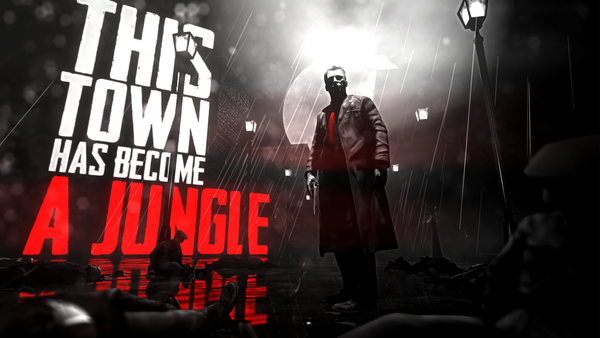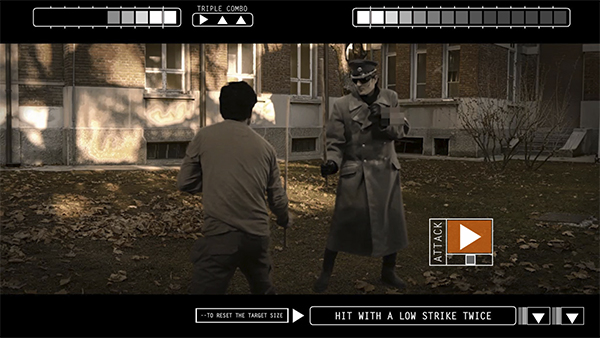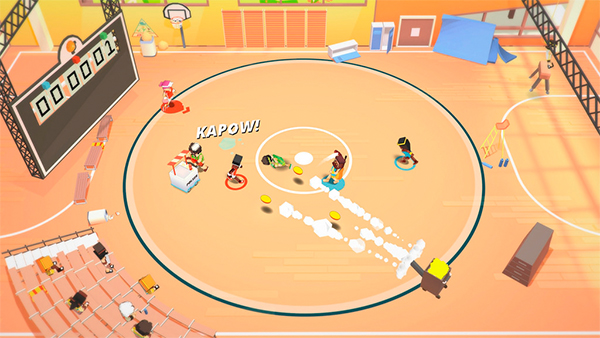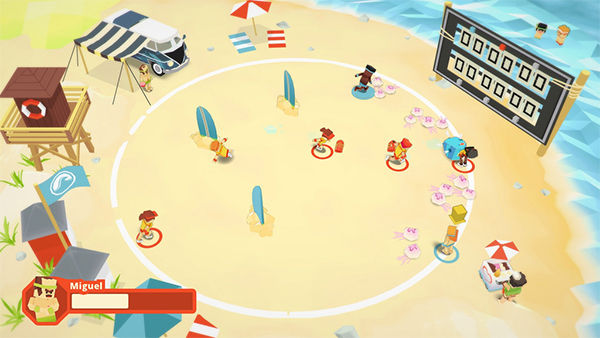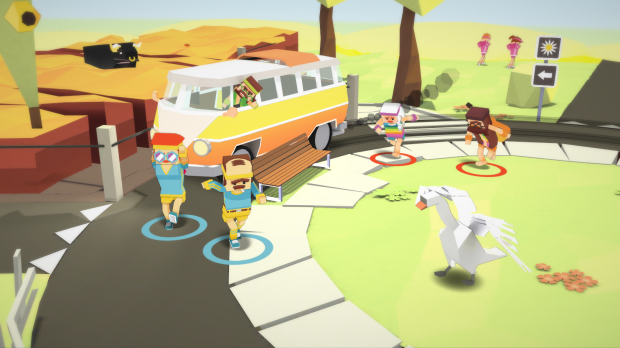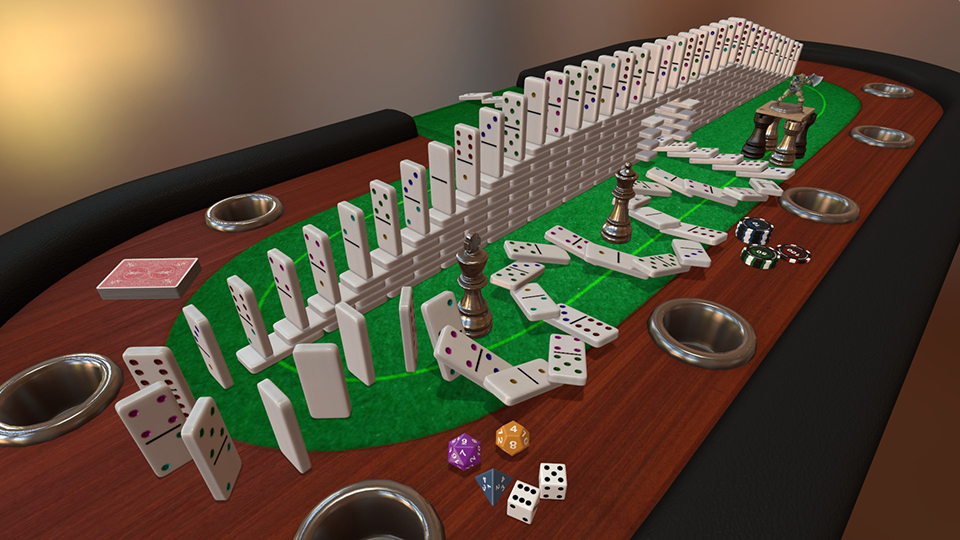Add your feed to SetSticker.com! Promote your sites and attract more customers. It costs only 100 EUROS per YEAR.
Pleasant surprises on every page! Discover new articles, displayed randomly throughout the site. Interesting content, always a click away
GamerNode
Play with purposeSunJack 14W Solar Charger with 8000mAh Battery Review 3 Nov 2016, 5:55 pm
Occasionally here at GamerNode we get our hands on products that are more generally tech related than specifically videogame related, but their value is evident for gamers and non-gamers alike. The SunJack 14W portable solar charger is one of those sweet little pieces of technology.
The SunJack is a set of 4 solar panels beautifully stitched into a foldable canvas casing, perfect for carrying off the beaten trail, or anytime one would expect to see plenty of sunshine but no available power outlets. That’s because the two 2-amp USB ports on the SunJack provide charging speeds comparable to a wall outlet while in direct sunlight.
Anyone with a cell phone, camera, Nintendo 3DS, PlayStation Vita, or any other portable electronic device could benefit greatly from the freedom the SunJack affords, be it on a multi-day camping trip or hiking expedition, a trip to the beach, a day at the park, or even just for convenience in the backyard. I took our review unit camping, and it made my tent a luxury, electrically-powered apartment for all of my USB-charged gadgets.
The SunJack 14W also comes with a removable 8000 mAh battery that can soak up that solar energy while the SunJack is unfurled, saving it for later like any other portable charger, so you’re not limited to the daylight hours. Its capacity is good for about four cell phone, five 3DS, three Vita, or one tablet charge, and it can be topped up via wall charger, as well. It even has a little built-in LED flashlight for after dark, which is super useful.
I’m particularly fond of the fact that the SunJack comes with a couple of carabiners, and has seven canvas loops divided between its two short ends to make hanging or properly aligning the panels easy to do. I’m not a huge fan of the zipper’s soft rubber pull tabs on the conveniently implemented mesh outer pocket, though. Those seem a little weak, but otherwise everything on the SunJack feels like it’s constructed to a very high standard of quality.
The SunJack is a great tool for anyone who needs a lot of portable power while off the grid. It really gets rid of the anxiety of a plummeting battery level indicator, so now you can feel free to spend hours upon hours in the middle of the park hunting Dragonite in Pokémon Go!
Mighty No. 9 Review 23 Sep 2016, 2:45 am
 Please allow me to save you some time. Go back and listen to episode 64 of the GamerNode Show podcast, then choose to play either the comprehensive Mega Man Legacy Collection or the fantastic love letter to the Mega Man series, 20XX, or both. Either will serve you better than Mighty No. 9, because both are superior games.
Please allow me to save you some time. Go back and listen to episode 64 of the GamerNode Show podcast, then choose to play either the comprehensive Mega Man Legacy Collection or the fantastic love letter to the Mega Man series, 20XX, or both. Either will serve you better than Mighty No. 9, because both are superior games.
Mighty No. 9 began as a hugely successful Kickstarter campaign, to the tune of $3.8 million. Billed as a spiritual successor to the Mega Man series and designed by a team of veterans of that series, including Keiji Inafune, backers came out in droves to lay down money on the promise of a reinvented Blue Bomber.
Nearly four years later, we have a game that approximates the style of the Mega Man series, taking the central concept of robots turned bad…and also turning the rest of the game bad, at least by comparison, and comparison simply cannot be avoided.
The basics are all there: the protagonist robot Beck – under the guidance of friendly scientist Dr. White – runs, jumps, and shoots his way through two-dimensional, side-scrolling levels filled with enemy robots and other hazards until he reaches the “Mighty No. Whatever” boss robot that lords over that particular area.
Rinse. Repeat.
And I say that not because of the fact that nearly every game in existence repeats its primary mechanic for its duration, but because this game just FEELS like “rinse, repeat” while others often feel like continuing to do something you enjoy doing.
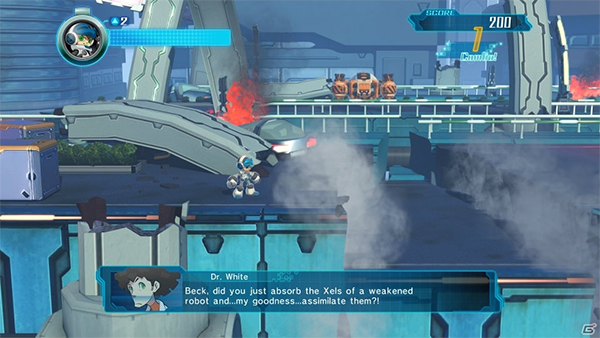
Mighty No. 9‘s level design is generic but with sections that try too hard to kill you, the character art is like an ugly 3D rendering of a cutesy children’s anime, and the voice acting is just plain awful. And it’s awful not only because of its quality but because of its frequency and timing. There’s a perpetual dialogue between characters as Beck runs through each level, with annoying voices narrating the obvious and stalling any feeling of momentum that has generated to that point. I would argue that removing these characters – and all voice acting – from the game completely would be a big improvement. Including them really nullifies any joy derived from playing.
The pure moment-to-moment gameplay, taken alone, is not bad. Sure, the level design and variety and placement of enemies could use work, and Beck is a little too bouncy and imprecise, and not quite responsive enough to player input, but running, jumping, and shooting are basically fun. The dash mechanic is even a step above that, and the driving force behind the momentum that is repeatedly crushed by those ruinous bits of dialogue from those stupid characters mentioned earlier. With better elements surrounding it, this mechanic could be the basis of a much stronger game.
In Mighty No. 9, rather than simply exploding to bits after a number of Beck’s blasts, enemies are first stunned, leaving them vulnerable to a dash attack. Defeating them in this manner captures their “Xel” energy, which translates into bonuses and upgrades for the player if the color-coded combo countdowns are kept up. Of course just shooting them to death works, too, but the crux of combat and game flow is this dash mechanic. And it’d be a whole lot of fun with better level design and no distractions. Anticipating the stun threshold of your enemies and chaining dash-kills together can feel like riding a wave through the level if play is uninterrupted.
But mostly, it is interrupted. So that’s theme of Mighty No. 9: disappointment. It’s a disappointment thanks to its Mega Man heritage, for sure, but even setting that aside, there is disappointment baked into gameplay. Disappointment is written into the code. I wish the game would stop getting in its own way and just let me play it.
Lost Castle Review 14 Sep 2016, 11:58 pm
 I dove into Hunter Studio’s Lost Castle expecting a simple hack-n-slash style action game, but was pleasantly surprised when I realized that the best comparison I could make to this fun and alarmingly difficult title is the stellar Rogue Legacy from 2013. This is a beautiful thing.
I dove into Hunter Studio’s Lost Castle expecting a simple hack-n-slash style action game, but was pleasantly surprised when I realized that the best comparison I could make to this fun and alarmingly difficult title is the stellar Rogue Legacy from 2013. This is a beautiful thing.
Lost Castle begins with an expositional cutscene describing how a spell gone wrong opened the floodgates for monsters to overrun the titular castle. It cleverly explains that the monsters essentially moved in with all their treasure, and when the word spread, adventurers came from far and wide to slay them and make off with their riches.
So what players are given by Lost Castle is a legacy rogue-lite action game with light RPG elements and some lightheartedly dark (is that a thing?) comedic writing as a cherry on top. Every new run into the castle puts a new adventurer under the player’s control, and with every inevitable death, upgrades and unlocks can be purchased with the monster souls they’ve collected in order to improve the chances of success on future runs. Of course, any gold or unused souls are sacrificed and the next random adventurer starts with nothing but the purchased upgrades.
Though it’s not an original concept, this is a fantastic system that hasn’t yet been overused by dozens (let alone hundreds) of games, and Lost Castle is fun and addictive because of it. The movement and combat can feel a bit clunky to start, but upgrades a player can purchase actually improve the game’s input response over time.
Adventurers will fight through the many rooms and corridors of the castle, mostly fighting a few variations on each of a handful of different grunt enemy types. The art is great, and is reminiscent of the aesthetic of the Paper Mario games with its flat-looking sprites drawn in a vibrant color pallette. The adventurers, especially, are fun to see at the outset of each run, as they are always just a bit – and sometimes very – different from one another. I was particularly fond of my axe-wielding, pink-pompadour-and-beard-adorned Brooklyn hipster dude, despite getting obliterated by an abnormally brutal first few randomly generated rooms.
Roguelike elements! Yes, all the rooms are randomized, as are the enemies, items, weapons, potions and aforementioned adventurers. Combined with the upgrade tree that always begs to be filled out just a little bit more, this randomization makes replayability one of Lost Castle‘s strong suits.
It’s difficulty doesn’t hurt it in that area, either. This game is certainly a challenge, and I’d be lying if I said I am confident that I stand a chance at ever defeating any more than one of the game’s room-sized bosses. Every time I wander haplessly into a chamber with the giant green slime or the playful cross between a t-rex and Super Mario’s Yoshi, I feel resigned to my impending demise.
But it’s a joyful cycle of death and rebirth in Lost Castle. What’s more, you can share the love with a friend in the game’s two-player cooperative mode. I really enjoy playing Lost Castle and would recommend that GN’s readers check it out on Steam. At only 8 bucks, you really can’t go wrong; it’s definitely worth a whole lot more than that.
The GamerNode Show 66: A Deer in Stage Lights 6 Jun 2016, 3:46 pm
Eddie Inzauto talks about the podcast’s name change, The Deer God, and Forced Showdown in episode 66 of The GamerNode Show.
Eddie Inzauto offers a pair of reviews on this “whatcha been playin'” episode of The GamerNode Show: The Deer God from Crescent Moon Games and Forced Showdown from BetaDwarf. A short and sweet update. More next week!
Versus Node theme “Dungeon” by Koji Kondo for Nintendo’s The Legend of Zelda, 1987, remixed by Brian Schulman and Charles Kantz, 2010.
GN on Facebook – http://www.facebook.com/GamerNode
GN on Twitter – http://www.twitter.com/GamerNode
Eddie on Twitter – http://www.twitter.com/EddieInzauto
Email us at – vsnode {at] gamernode [dot} com
For a direct link to the podcast feed, click here.
(audio/mpeg; 31.01 MB)
Dark Souls III Review 3 Jun 2016, 10:50 pm
 Just uttering the name can strike fear into the hearts of unhardened heroes. Only the fiercest, most grizzled, and perhaps most masochistic warriors possess the mettle to face the many challenges that lay ahead, be it across the land of Boletaria, Lordran, Drangleic, or the latest dark frontier of Lothric.
Just uttering the name can strike fear into the hearts of unhardened heroes. Only the fiercest, most grizzled, and perhaps most masochistic warriors possess the mettle to face the many challenges that lay ahead, be it across the land of Boletaria, Lordran, Drangleic, or the latest dark frontier of Lothric.
Dark Souls III continues the saga of courageous undead heroes fighting to rekindle the First Flame and prolong the Age of Fire, thereby saving the world for yet another cycle of relative peace from the horrors that arise as the flame dwindles and darkness encroaches.
For players, that means that FromSoftware and Hidetaka Miyazaki have built yet another massive world to explore, full of formidable foes, great and small. And while difficulty in the Souls-iverse has proven to be entirely subjective due to the wide range of character builds, combat strategies, and custom-forged weapons available, this may very well be the toughest journey to date.
Dark Souls III is once again helmed by the director of the first three Souls games, and after some negative response from the most entrenched of the Souls community to Dark Souls II (an excellent game that brought great improvements to the series, by the way), much of what’s found in this newest entry feels crafted to oppose elements of that game’s design and call back to Dark Souls and even the seminal Demon’s Souls. Dark Souls III therefore feels somewhat like an anthology of Souls history or an amalgamation of elements from its predecessors.
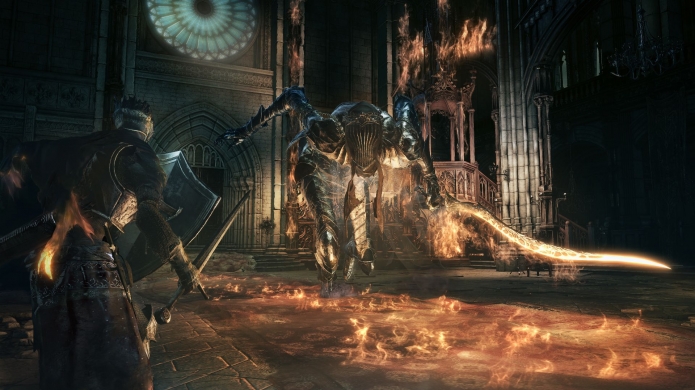
And the choices are mostly strong. Enemy design is creative and varied, giving players new and interesting foes to combat throughout the adventure. This is only amplified by the fact that enemy behavior and attack patterns follow suit and keep players guessing with each new onslaught. The game’s pace seems to have taken a cue from FromSoftware’s 2015 game, Bloodborne, making combat feel more active as a result.
For those who know and love the Souls franchise for its more measured, cautious exploration, however, this may strike a subtle chord and leave a particular itch unscratched, because for every step to “improve” combat in this way, some of the old atmosphere is lost.
Which brings me to perhaps the most unwelcome change in Dark Souls III: a notable homogeneity in its art direction. Level design—pathfinding and progression—has shifted in a way that will please some and disappoint others, but the aesthetic design of the environments in Dark Souls III has lost its diversity, and with it much of the sense of wonder that came with stepping into a new area for the first time in previous games. Here, most of the areas serving as backdrops to the famous Souls gameplay are stone castles or stone towns or stone catacombs or stone roadways. There’s still an impression of size and expanse—you can look back from a later area and see your journey’s distant starting point in miniature rising above the horizon—but these views no longer inspire awe quite the way they did in the past.
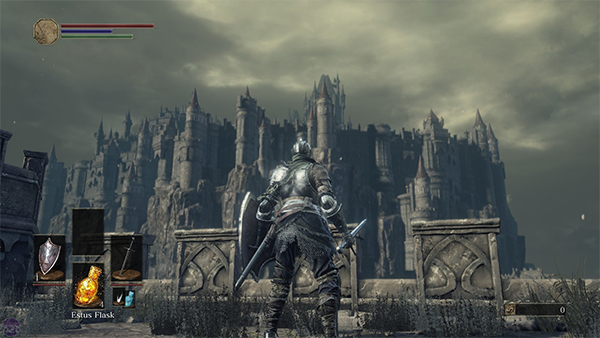
Exploration suffers on a visceral level due to this change of scenery, or lack thereof. And because the geography of Dark Souls III consists mostly of a string of discrete areas on a continuous path, the opportunity to direct one’s own adventure feels somewhat revoked in this game, as well. Previous Souls titles consistently put players in a position where they could choose their next move from a number of possible paths forward to who-knows-where. Dark Souls III presents an intricate and impressive web of pathways within each area, but the overall map features fewer branches, and therefore less mystery and trepidation to the adventure as a whole.
It’s in the mechanics that Dark Souls III‘s fire burns brightest. The aforementioned enemy AI works in synergy with a refined and improved combat system that includes new weapon-specific skills as well as a new system via which players divide their estus flask’s healing ability between health and focus points, the latter of which power both skills and spells. These elements, along with a general tightening of controls across the board, add layers of depth and complexity to what was already a brilliant design from a mechanical perspective.
For some, this will be enough. The tactile feedback of a world fighting as hard as ever back against you will be incredibly satisfying, and the difficulty upon which the legend of the Souls games has been built is at its peak in Dark Souls III. But for others, the essence of the Souls games lies in its world, oppressive and daunting not simply because of its inhabitants but by virtue of its mood; by the character of the place itself. While it was still great, Dark Souls III just couldn’t captivate me to the extreme degree that its predecessors—my favorite games—were able to do. For me, the fierce opposition in these games may be what fuels their challenge, but it’s the world that consumes my soul.
Blues and Bullets – Episode 1: The End of Peace Review 21 Apr 2016, 6:31 pm
 For an episodic noir detective drama, Blues and Bullets is quite surrealist, seemingly inspired in equal parts by Telltale adventure games, Sin City, and occult horror such as Silent Hill. These far more so than the U.S. history from which it borrows, as it takes full creative license with characters Elliot Ness, Al Capone, and the events surrounding their prohibition-era rivalry. In fact, the inclusion of such characters is all but superfluously painted onto a related, yet distinct, narrative.
For an episodic noir detective drama, Blues and Bullets is quite surrealist, seemingly inspired in equal parts by Telltale adventure games, Sin City, and occult horror such as Silent Hill. These far more so than the U.S. history from which it borrows, as it takes full creative license with characters Elliot Ness, Al Capone, and the events surrounding their prohibition-era rivalry. In fact, the inclusion of such characters is all but superfluously painted onto a related, yet distinct, narrative.
In Episode 1: The End of Peace it’s the year 1955 in a faux-Chicago called Santa Esperanza, and an aging Elliot Ness struggles with booze and the memories of dead friends and his crusade against Al Capone, which ended in an all-out gunfight rather than clever paperwork. A parallel storyline opens the adventure, and gives teasing glimpses into a cult obsessed with kidnapping and “punishing” children before we switch to Ness and an investigation that sets the two ends of the narrative on a collision course. It is intriguing and gripping from the outset.
The pace of our hero detective’s activity is fairly slow to start. Some expository dialogue at his titular, post-retirement Blues and Bullets diner eventually puts the man back in action and on the case. The conversation system feels rewarding despite its limits. A few emotional notes are what players have to go on before watching and listening to Ness’s response. Any consequences of dialogue choices are invisible, but with options to reply in completely opposite tones, as well as to lie outright in some instances, one can be sure there is at least a momentary effect to these selections.
The most notable aspects of the game, aside from the dark and mature themes pervading the narrative, are things that greatly assist in developing that dark mood. The visual style is one of high contrast shafts of light and deep shadows, with splashes of red often appearing somewhere in the frame. It is as noir a presentation as I’ve seen in a modern video game, and works wonders for player engagement and commitment to the setting.
Unfortunately, it took me a PC upgrade to actually enjoy it, as the game is not very well optimized, technically. On anything but the strongest machines, the game will suffer slowdown frequently. Even at low settings, the system requirements for a smooth experience are unusually high. The game has just now come to PlayStation 4, where one would expect the uniform specs to have guided the development team in optimizing the port. When the game is firing on all cylinders, however, it’s a sight to behold.
Blues and Bullets features some light, cover-based third-person shooting sequences. These are enjoyable, and seem appropriately constructed for what is primarily an adventure game. These parts of the game don’t require high-level twitch-response shooting skill, and most gamers should be able to participate here without failing and breaking the flow of the story. The real crux of the play mechanics, however, lie in a much more deliberate and cerebral activity: crime scene investigation.
Episode 1 gives players the first taste of Blues and Bullets‘ robust and unique investigation system. Ness must explore a crime scene, discover potential clues, and then place them on a crime board menu arranged as a tree of connected elements to piece together what happened. The sequence of events is already more complex in this first episode than in other games of this genre, which is the most refreshing part. I may have thought I had an idea of how a clue fit into the chart and what it may have implied, but when I was wrong and eventually figured out why, it was perfectly reasonable to have deduced that information from the clue as it had been observed. I enjoyed this aspect of the game very much, and suspect most players will, as well.
Playing out as a mystery, the game affords itself the opportunity to keep players on edge, guessing what is yet to come, especially after playing through revealing investigations or taking short peeks into the disturbing goings-on at the underground cult lair, as The End of Peace showed us just before rolling the credits. I expect great things from this episodic series, and while the massive 8-month wait for Episode 2 is not a habit I’m hoping developer A Crowd of Monsters intends on maintaining, it does suggest they have spent the time to improve the areas of the game that were clearly in need in Episode 1. As it stands, Blues and Bullets is undoubtedly worth playing, and now there’s finally a second episode (of five) to look forward to, as well.
Stay Dead Evolution Review 21 Apr 2016, 3:31 pm
 It’s 1992, and Mortal Kombat has used digitized sprites to represent the characters fighting one another on screen, while games like Night Trap and Phantasmagoria were incorporating full-motion video (FMV) of live actors to portray the characters in their stories. This era fell somewhere in between the 1980s laserdisc games built entirely around on-screen button prompts to propel the action and Shenmue‘s famous 1999 introduction of quick-time events (QTEs) into the mainstream. Stay Dead Evolution is a fighting game trapped somewhere in the midst of all this, and struggles to find its footing or deliver any true entertainment value for more than a few minutes.
It’s 1992, and Mortal Kombat has used digitized sprites to represent the characters fighting one another on screen, while games like Night Trap and Phantasmagoria were incorporating full-motion video (FMV) of live actors to portray the characters in their stories. This era fell somewhere in between the 1980s laserdisc games built entirely around on-screen button prompts to propel the action and Shenmue‘s famous 1999 introduction of quick-time events (QTEs) into the mainstream. Stay Dead Evolution is a fighting game trapped somewhere in the midst of all this, and struggles to find its footing or deliver any true entertainment value for more than a few minutes.
Stay Dead Evolution is essentially a QTE game; the only player input is tapping the correct arrow key when a box moving horizontally across the screen enters another, larger box. Sometimes an arrow appears in the larger box, in which case the player must match the direction, but at other times any arrow key will do, with double-taps and three-tap combos rounding out the extent of the controls.
The system, unfortunately, isn’t very good, and arguably broken. It starts out with huge target boxes and a slow-moving cursor box, so the first opponent will be a joke to defeat on any difficulty level. This remains the case for the entire duration of the base difficulty setting. The second match of subsequent difficulty levels shows a huge disparity from the initial fight, with tiny target boxes that continue to shrink, and a cursor box that zooms across the screen. I would describe this difficulty curve as mildly infuriating.
The other unique-for-its-time aspect of Stay Dead Evolution is that the characters are all live actors, shot on green screen, performing individual attacks that are repeated stiffly with each successful attack or defense command. No polygons, no sprites, and short video clips of the action from different angles replacing rendered animations. There are painfully few of these clips, though, so you’ll end up seeing the same punches, kicks, and blocks from the same angles over and over.
Really, there just isn’t enough of anything in Stay Dead Evolution. It needs more characters, more moves, more (and more sensible) arenas, and more variety of player commands. And perhaps most importantly, it could probably entirely revamp its QTE system. We loved QTE in Resident Evil 4, Heavy Rain, and all the God of War titles, among others, so with a little more care and production time put into Stay Dead Evolution, we could have had a nostalgic and enjoyable experience instead of a mess made out of 90s game mechanics.
Stikbold! A Dodgeball Adventure Review 6 Apr 2016, 7:13 pm
 I can’t help but think of Nintendo while playing Game Swing and Curve Digital’s wacky twin-stick arcade dodgeball game, Stikbold! A Dodgeball Adventure. If this surprisingly fun couch co-op title starred Mario, Luigi, Peach, Toad, Bowser and the gang, and perhaps threw in a couple of additional game modes, I feel like excited gamers would line up to throw money at a new reason to crowd around their Wii U and get boisterous with their friends.
I can’t help but think of Nintendo while playing Game Swing and Curve Digital’s wacky twin-stick arcade dodgeball game, Stikbold! A Dodgeball Adventure. If this surprisingly fun couch co-op title starred Mario, Luigi, Peach, Toad, Bowser and the gang, and perhaps threw in a couple of additional game modes, I feel like excited gamers would line up to throw money at a new reason to crowd around their Wii U and get boisterous with their friends.
But Stikbold! is not a Nintendo game, it’s the product of the 2013 Nordic Game Jam, finally making its way to Steam, PS4, and Xbox One this week from a small indie developer based in Denmark. And it’s a trip. It’s bright, colorful, silly, funny, and built on a simple yet solid set of mechanics that will keep you playing match after match.
Stikbold! may be disguised as a “sports” game with voxel-inspired character design and a 70s theme, but it feels more like a marriage of a twin-stick shooter and a single-screen action combat game, à la TowerFall, than it does any sports game. It’s another entry in a series of mostly independent titles released over the past few years that put the emphasis back on playing with friends by your side rather than via a network connection.
A short but entertaining Story Mode, playable either solo or cooperatively, sees our heroes Björn and Jerome on the brink of winning the stikbold (that’s Danish for dodgeball) championship by default after the Devil abducts the opposing finalists. The two instead opt to rescue their nemeses and travel as far as the ocean and as deep as the pits of Hell before returning to the old gym.
Along the way they compete in a number of somewhat standard dodgeball matches that take place on a small selection of themed courts (traffic circle, beach, oil rig, etc.), each with its own brand of outside interferences to make things just that little bit more crazy. Punctuating the experiences in these diverse locales are a handful of interesting boss battles that use the game’s usual mechanics to challenge players in new ways; one such adversary being a belly-flopping, detritus-spewing whale that can only be defeated by pushing TNT into its gaping, vacuum-like mouth at key moments throughout the match.
So how do you actually stikbold, bro? It’s simple. Move around with the left analog stick while using the right analog stick to change the direction in which your dodgeballer is aiming, then pull and hold the right trigger to charge a shot and release to throw. Without a ball, this input punches/shoves and strips the ball from an opponent’s clutches. The right bumper or R1 button passes and the left trigger performs a dodge, which doubles as a catching mechanic when timed just right. This ability to catch incoming projectiles was one of my favorite parts of TowerFall, and fans of either game will undoubtedly love it once they’ve mastered the technique. And curving shots? The pinnacle of dodgeball satisfaction!
As in other competitive action games and popular brawlers, Stikbold! will primarily be played in multiplayer mode. Up to four local players can participate in team or free-for-all matches on any of the game’s courts, with full control over the win conditions, rules, and environmental hazards affecting play. Bots can be added to max matches out at six, and things get incredibly hectic with six characters on screen at one time. Teams don’t even have to be equal, so mismatching can be either a challenge or a massacre for “friends” to partake in.
Stikbold! A Dodgeball Adventure is great fun. I would love to see more levels and options, or even special powers or variable attributes among the cast of dodgeballers, but at $10 (on sale for $8 for the next 48 hours at the time of this review) it’s got a huge fun-to-expense ratio, and is worth picking up if you’ve got a friend or three who will come over and re-live the glory days of couch co-op with you, laughing, shouting, and trash-talking through match after match.
Ticket To Ride & Ticket to Ride Pocket Review 4 Apr 2016, 7:55 pm
 Ticket to Ride for iOS is proof that parallel universes really do exist. While America’s best and brightest are bent over their game tables, cleverly hoarding cards and laying routes, a dedicated community of Ticket to Ride Appsters is perfecting its craft. This digital universe of tickets and trains, inhabited by players of all ages and nationalities, is not only governed by advanced tactics and strategies, but a code of etiquette all its own. But before we get to the juicy bits—the politics and intrigue of laying cyber tracks—let’s talk about the app itself. For starters, there are two iterations, Ticket to Ride Pocket and Ticket to Ride, the full version.
Ticket to Ride for iOS is proof that parallel universes really do exist. While America’s best and brightest are bent over their game tables, cleverly hoarding cards and laying routes, a dedicated community of Ticket to Ride Appsters is perfecting its craft. This digital universe of tickets and trains, inhabited by players of all ages and nationalities, is not only governed by advanced tactics and strategies, but a code of etiquette all its own. But before we get to the juicy bits—the politics and intrigue of laying cyber tracks—let’s talk about the app itself. For starters, there are two iterations, Ticket to Ride Pocket and Ticket to Ride, the full version.
TTR Pocket is a decent option for the sporadic player. TTR Pocketeers can play against other in-network players and go head to head with online competitors. The key downside of TTR Pocket is that it only includes the United States map. This might suffice for more casual players, but for diehard TTR Appsters this might be a frustrating setback; it prevents you from initiating or joining online games with any map other than the original. This can seriously limit the number of online transcontinental duelists with whom you can match wits, but there is a loophole that allows TTR Pocket players to join full TTR games on the expansion maps if invited directly by a buddy who has purchased the expansion in question, so all hope is not lost.

The full version, however, opens the door to train wonderland. If one is willing to pay the modest price for upgrade, one has access to the full panoply of international boards (save United Kingdom, Pennsylvania, and Africa). For those less familiar with the Ticket to Ride game series, this includes the United States, Switzerland, Asia, India, and Europe. The cyber expansion packs are certainly more financially savvy than purchasing each of the real-world versions. Luckily, there’s no need to put cash on the line for the United States expansions: 1910, Mega, and Big Cities come complementary with the full version of the game. But if you’re in the market for the full smorgasbord, it’s most economical to buy the full version straight away for $9.99.
Additionally, the full version of Ticket to Ride includes the much-loved Single-Session multiplayer mode, which requires games to be attended for the full duration of the competition. TTR Pocket is limited to the asynchronous Multi-Session mode, which is, again, more suitable for the casual player or anyone on the go with intermittent data coverage or other reasons for interruption mid-game. Multi-Session games are, of course, included in the full version, as well.
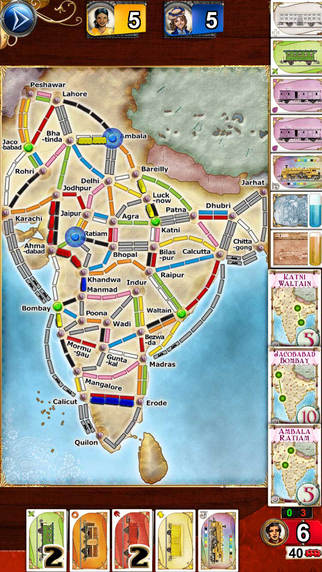 Given the elegant simplicity of the real-world game, it should be no surprise that it translates beautifully to iOS or Android. Apart from the unsettlingly disproportionate illustrations on the original board (a swordfish of mammoth proportions, a trio of travelers the size of Texas), the app version is an exact replica. For neat freaks, the app even has some particular advantages: the draw pile and tableau of face-up cards are always perfectly kempt. Players’ hands are equally clear. One’s cards appear at the bottom of the screen. The clutter of card hoarding is conveniently reduced; instead of showing each individual card a player possesses, the game superimposes a number on each colored stack, indicating how many of that color a player has managed to collect.
Given the elegant simplicity of the real-world game, it should be no surprise that it translates beautifully to iOS or Android. Apart from the unsettlingly disproportionate illustrations on the original board (a swordfish of mammoth proportions, a trio of travelers the size of Texas), the app version is an exact replica. For neat freaks, the app even has some particular advantages: the draw pile and tableau of face-up cards are always perfectly kempt. Players’ hands are equally clear. One’s cards appear at the bottom of the screen. The clutter of card hoarding is conveniently reduced; instead of showing each individual card a player possesses, the game superimposes a number on each colored stack, indicating how many of that color a player has managed to collect.
Destination cards sit just to the right, forming a virtual pile that can be shuffled through click by click. When a player is ready for new destination cards, he taps his destination deck and out slides a cute little ticket with a plus sign. Clicking on the plus sign and confirming one’s desire to accept new destination tickets earns a spread from which to choose. On the far right is a player’s master panel, complete with avatar, screen name, score, and remaining trains. Clicking on opponents’ panels allows one to see how many destination tickets, trains, and cards she has (although once a player amasses more than eight card, it reports only “8+”).
The Ticket to Ride mobile game offers some key advantages over the real-life game. The original is perfect for leisurely, lighthearted games with friends and family. The app is the better bet for those deft of mind and quick of finger. It successfully streamlines game mechanics, allowing players to draw cards and lay trains in a fraction of the time it would take in real life. I recently played a modestly paced, real-life, four-player game in my living room that took almost two hours. In contrast, a four-player game on my phone takes me approximately thirty minutes. Of course, the online version pales in comparison when it comes to playful banter, poker faces, and showboating. But it’s still surprisingly social.
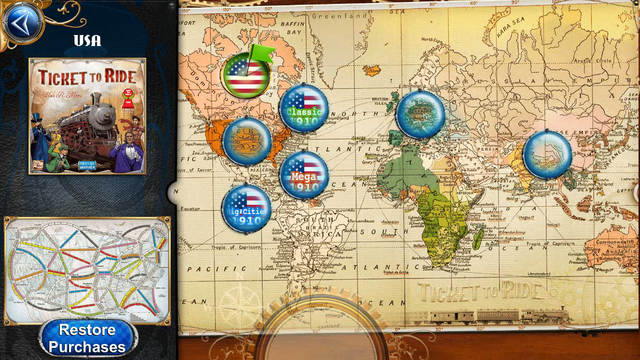
Ticket to Ride is also delightfully cosmopolitan, although English is (as one would expect) the default language in all games. Players can message each other in various ways during matches and when waiting in the digital “lobby.” I’ve started many a game with a friendly “Hi!” or waving avatar from my opponent. In one game, we joked while we stumbled all over each other to build trains, having all chosen destinations tickets in the Midwest. In a bizarre move, a Dutch opponent hit on me. Laments about bots (which replace you when you leave a single-session game or—gasp—when your app momentarily crashes) are common: They tend to use cards frivolously.
Now for the juicy bits! Ticket to Ride is governed by a simple yet serious system of etiquette. Intentional blocking is considered generally in poor taste. Intentional blocking is more than just annoying; defensive play suggests a lack of tactical skill. Players will specify their block preferences in their game titles. “NO BLOCKING,” is a common theme, “no intentional block!” is another. Conversely, cutthroat competitors ominously warn “anything goes.” Slowpokes are also disfavored. Game times can be capped, with each player afforded a specific number of minutes (my sweet spot is nine), and bots replace those who unwisely run down the clock. Players are also known to pointedly display yawning avatars when an opponent seemingly vanishes mid-game (or mid-turn).

Lastly, those in the community who care about ranking tend to be strict about it. Many games request players above or below a certain ranking. I once entered a 1350+ game with a lower ranking and was promptly chided by the creator. He begrudgingly played me anyway. However, on the whole the community is generally amicable and skilled. I’ve had players praise me for “good form” or congratulate me on a “good game.” It’s a nice feeling to have one’s train-building skills validated by a friendly stranger from halfway across the world.
In sum, Ticket to Ride should be freely and highly recommended to any and all interested parties, with TTR Pocket an acceptable first step for the less enthusiastic. The interface is easy to use and a consummate replica of the original. The ability to play strangers and invite friends to private games means you’ll never be stuck without a partner. But be careful. The game is most definitely a hindrance to personal productivity. One player’s username says it all: TrainAddict.
Tabletop Simulator Review 8 Feb 2016, 3:26 am
 With the advent of three-dimensional graphical rendering in video games, and most notably the release of the seminal Grand Theft Auto III, open-world games, dubbed “sandbox” titles, experienced a huge surge in popularity among gamers—a surge that in many ways continues today. The year 2015 saw the release of a different type of sandbox in Nintendo’s Mario Maker, a game dedicated as much to game creation as it is to actual play. This has been a less popular genre over the course of gaming history, but standout examples have made their appearance throughout the years, as well. Mario Paint, RPG Maker, and even the unique and wonderful storytelling platform Sleep is Death come to mind.
With the advent of three-dimensional graphical rendering in video games, and most notably the release of the seminal Grand Theft Auto III, open-world games, dubbed “sandbox” titles, experienced a huge surge in popularity among gamers—a surge that in many ways continues today. The year 2015 saw the release of a different type of sandbox in Nintendo’s Mario Maker, a game dedicated as much to game creation as it is to actual play. This has been a less popular genre over the course of gaming history, but standout examples have made their appearance throughout the years, as well. Mario Paint, RPG Maker, and even the unique and wonderful storytelling platform Sleep is Death come to mind.
Tabletop Simulator walks the path of those latter titles, but represents a much truer example of a sandbox in a traditional sense. Tabletop Simulator is an unusual, but not a strange concept. It’s essentially a physics engine designed specifically to simulate the experience of sitting at a table and interacting with cards, dice, board games, miniatures, and just about anything else one might play with in a tabletop environment.
The controls are intricate and precise, with keyboard keys or gamepad buttons dedicated to manipulations such as flipping and rotating items, stacking and shuffling stacks of cards or tiles, raising components to eye level for closer examination or reading text, rolling dice, etc. It’s a full suite of controls that, once mastered, makes playing the game at hand feel almost seamless and surprisingly realistic.

I have not personally delved into the creative aspect of Tabletop Simulator, but judging from what is available in the game’s Steam Workshop—a pool of user-created content that is continuously updated by enthusiasts more creative and ingenious than I—the available tools make just about anything possible. I’ve spent hours sampling the Workshop items, and the ways users have implemented various options in the toolset is truly impressive.
Essentially, anything that can feasibly be played on a tabletop can be reproduced in Tabletop Simulator, so what eventually lies in front of a player is a full range of classic board and card games, which are included in the main game straight away, as well as dozens of regularly updated user entries. All of these options can be played online with groups of other eager tabletop gamers via custom servers wherein one participant is the host and the rest connect to that player’s computer to join the game. Both text and voice chat are incorporated into Tabletop Simulator to facilitate matchmaking from the lobby, friendly banter, or heated trash-talking.
Tabletop Simulator is a toolkit, and it works incredibly well to serve the functions for which it was designed. With the glut of content coming out of the game’s Steam workshop, I would go so far as to say that it would be foolish for any board, card, or miniatures gamer to not buy it. Once a player explores the depths of what’s available in this physics sandbox, its value becomes monumentally clear. If you’re not into tabletop games, however, you’re not going to miraculously find the next Call of Duty hidden somewhere inside.



